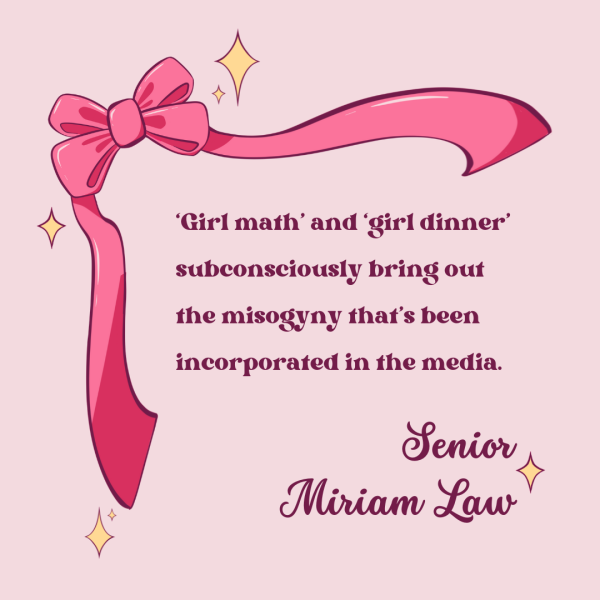From pink bows to the lights and glamor of Barbie Land, social media has seen a surge of femininity, coined as “girlhood” by the various trends highlighting what it means to be a girl today. Women have also begun taking over realms beyond social media, making their way to mainstream media and award shows such as the Grammys, as seen in the 2024 Grammys, where women won in all four major categories: Record of the Year (Miley Cyrus with “Flowers”), Song of the Year (Billie Eilish with “What Was I Made For? [From The Motion Picture ‘Barbie’]”), Best New Artist (Victoria Monét) and Album of the Year (Taylor Swift with “Midnights”).
The rise of girlhood followed the release of the live-action movie “Barbie” in July 2023, as the movie inspired women to begin posting their appreciation for being a woman on social media. History Department Lead and AP U.S. History teacher Bonnie Belshe says the “Barbie” movie serves as a litmus test for the men in one’s life, as their reaction to the film speaks volumes on their stance in the feminist movement. She also comments on the events at the Grammys, stating how these further prove the evolution of the feminist movement in the past year.
“For a very long time, women have been very vocal and very active, not just at the Grammys, but in every aspect of social and cultural movements,” Belshe said. “It’s not that the events at the Grammys are coming out of nowhere, it’s that there is this long thread of work that women in the past and current have done to get to this point.”
Belshe remembers growing up with shows and toys that were heavily marketed towards boys and expressed excitement to see the media shift from being patriarchal and male-focused to more gender inclusive. However, she notes that feminism was and remains a non-inclusive experience.
“White women centered their experience as kind of as default, not considering a very intersectional look at feminism,” Belshe said. “As a white woman, it is very important that we understand our whiteness affords us much more safety and privilege.”
Belshe also brings up the Smithsonian’s display on girlhood, which features a dress created by Isabella Aiukli Cornell, who is part of the Choctaw Nation in Oklahoma. Cornell created the dress for a high school prom, and the red dress features elements from Indigenous culture. Belshe cites this as an inspirational and key example of intersectionality between the feminist movement and ethnicity.
Junior Lucy Yung agrees with the idea that feminism can be a limited movement and notes that the concept of girlhood combats that lack of intersectionality. According to Yung, girlhood has made feminism more inclusive for women of color, as the movement is relatable to everyone, regardless of ethnicity.
“There’s two types of feminism: there’s feminism and then there’s white feminism, where it’s white women only focusing on themselves or the rich,” Yung said. “I think girlhood spans across everything because it’s just girlhood. I don’t think it has a look to it. It’s just girls being girls.”

At the same time, Belshe has seen a recurring gender divide in how products are marketed, with a clear separation between what toys are advertised for what gender. She notes that toys and shows are specifically marketed towards boys or girls. She says this sends a toxic message that contradicts the gender unity proposed by feminism.
According to Belshe, the heightened representation of girls comes in a pink hue, with toys and other media being packaged in a pink, stereotypically feminine manner, which contrasts with how toys intended for boys are marketed in a more stereotypically masculine way. Belshe states that the best way to combat this issue is to eliminate gendered packaging as a whole, raising all genders the same way rather than creating expectations.
Similarly, senior Miriam Law dislikes how the concepts of girlhood shown on social media create a gendered message. For her, attaching girlhood to simple concepts undermines the seriousness of the movement, as many stereotype women as ditzy rather than intellectual.
“I feel like ‘girl math’ and ‘girl dinner’ subconsciously bring out the misogyny that’s been incorporated in the media,” Law said. “‘Girl math’ implies that girls are dumb, or they don’t have common sense and they need things to be explained to them at a kindergarten level for them to understand, and ‘Girl dinner’ is promoting eating disorders and unhealthy eating habits that girls are supposed to have.”
However, Yung disagrees, and finds many of these TikToks relatable. She sees them as light-hearted jokes that can even be unifying since they highlight the mutual experiences of many women and add positivity to potentially toxic situations.
“I see how some people don’t like ‘girl math’ because it’s not actual math, but I think it’s funny, but not in a bad way, ” Yung said. “It makes sense to me because that’s also how my brain works. I also love ‘girl dinner.’ I think it’s good for people who struggle with eating because a ‘girl dinner’ is a happy dinner, and you get to eat whatever you want. It’s a way to bring joy.”
Ultimately, Law and Yung say the concept of girlhood has helped women come together and become more confident in their self-expression. To them, media like the movie “Barbie” and girlhood TikToks help create a community for women to understand themselves and what it means to be a woman.
“I think the trend is good because the world is just not equal and I think it’s really hard when other girls are hating on other girls,” Yung said. “And so when girls start supporting girls, it makes our lives a lot easier.”
Law also says this appreciation for girlhood and femininity should be integrated into how children are raised, as this will allow them to feel more comfortable with their gender earlier on in life. She hopes this will unify genders and decrease misogyny for future generations of women.
“It will help fight against what girls may experience in real life,” Law said. “I know that even from a young age, they will still face misogyny like objectification. So while social media isn’t the healthiest for a young audience, at the same time, hopefully there’s enough of that media that will reassure them that girlhood is good to experience.”

Belshe agrees with Law, noting how social media has historically been toxic by creating a misogynistic environment, impacting teenagers the most. She notes that parents and teachers must support and empower children to leave behind the misogynistic mindsets of the past and instead strive towards a united society.
“Part of girlhood is the mentors that have been there before and how we can help hold the hand of girls going through life because it’s not easy, especially now with social media in particular,” Belshe said. “That’s part of my role as a teacher, holding your hands and telling you that there are going to be difficult times, but you’ll always have the women that came before and we’ll make sure that you get there with us.”












